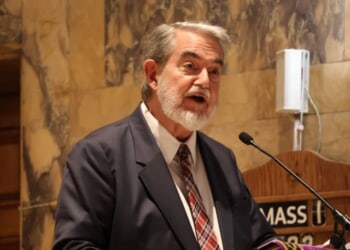The National Interest attends an event held on international partnership in space.
On April 16, 2025, the Royal Aeronautical Society’s (RAeS) Washington, DC branch sponsored an event at the Embassy of Canada to the United States titled “The 2025 Enduring International Partnership In Space Summit.”
As I previously noted in a February 24, 2025, article on an event at the British Embassy, RAeS was founded in 1866 and is the world’s only professional body dedicated to the entire aerospace community, established to further the art, science, and engineering of aeronautics. RAeS’s Washington, DC branch was formally inaugurated on December 17, 2003, coinciding with the centenary of manned flight by the Wright brothers.
Key Takeaways from the Event
Though all the speakers were excellent and provided fascinating perspectives, due to spatial limitations and the fact that I am a defense specialist, this article shall focus on the military officers’ contributions to the summit.
Air Marshal Paul Godfrey, Assistant Chief of Space Operations for Future Concepts and Partnerships, U.S. Space Force, began on a humorous note, including a self-deprecating joke about his previous days as a Harrier jump jet pilot (“How do you know when you have a Harrier pilot at your party? He’ll tell you!”) before describing three key goals for space security:
- Shaping Futures: the essence of being integrated by design, and deterring and defending against adversaries.
- Harnessing the CSpO (Combined Space Partnership Organization): it started ten years ago with the Five Eyes and has since grown to ten partners (Australia, Canada, France, Germany, Italy, Japan, New Zealand, Norway, the United Kingdom, and the United States).
- Engaging NATO: NATO declared space an operational domain in 2019; space isn’t just a military domain but a vital part of our everyday lives.
The air marshal also touched upon three stages of Global Integration:
- Force Design (five to fifteen years)
- Force Development (two to seven years).
- Force Employment (zero to three years)
Col. Barry Leonard, the Canadian Forces Air and Space Attaché and a former CH-124 Sea King pilot, discussed how industry also plays an indispensable role in space security and the need for a whole-of-country approach, i.e., military, civilian government, industry, and academia; public and private sector alike, across all borders, domains, and differences.
Q&A Session
During the Q&A portion of the Partner Nations Discussion, I posed the following question about the proverbial elephant in the room, i.e., shielding our satellites fromelectromagnetic pulse (EMP) threat,
Air Marshal Godfrey was the first to tackle my question:
“So, don’t underestimate the vulnerability of Earth-based infrastructure for space as well, and that’s an ongoing conversation within Combatant Commands. And so when you have things like a Critical Assets List and a Defender Assets List, all of a sudden you’ve got a number of space-specific areas that are really critical and they need to be defended as well, which takes resources from the other domains. So that is always an ongoing conversation when you go out and wargame these sorts of things. Guess what: from a protect-and-defend perspective from the United Kingdom, we might not have had anything in orbit, but there are all sorts of things you can do in the physical and the cyber domains to potentially negate a threat.
From there, he got to the crux of my question:
“So, I think that brings up a really interesting point. You know, the EMP side of things, both of us mentioned this sort of potential for nuclear weapons in orbit, I think all bets are off, because EMP radiation protections, those sorts of things, there are, I bet you, a number of people in the audience way more qualified to talk about this than me. But the cost vs. benefit potential for that to actually happen means that you’re probably not going to pay for it, which means you probably are going to be vulnerable to it at the end of the day. I guess the closest [analogy] is like Heathrow not having too much snow-clearing equipment: when it happens, it’s a really bad thing and everything shuts down, but it doesn’t happen that often, so it’s probably the right thing not to be spending millions and millions and millions on snow-clearing equipment that just sits there and needs to be maintained. It’s kind of the same thing from an EMP perspective.”
Col. Leonard added the following:
“Yeah, so I am the Luddite in the room when it comes to an EMP-based question, as I was kind of mulling it about in my brain. I think one of the problems in space is when you’re looking at older assets that are already in space, how do you protect those? You can design something now perhaps that’s set up to withstand those or at least reduce the vulnerability to a form of attack like that in space. You can repair stuff on the ground, and you can prepare for those types of things, or you can accept the risk because you can work your way through on the ground. The issue is: what do you do with those pieces in space that are already there? That’s a tough one for sure.”
About the Author: Christian D. Orr
Christian D. Orr was previously a Senior Defense Editor for National Security Journal (NSJ) and 19FortyFive. He is a former Air Force Security Forces officer, Federal law enforcement officer, and private military contractor (with assignments worked in Iraq, the United Arab Emirates, Kosovo, Japan, Germany, and the Pentagon). Chris holds a B.A. in International Relations from the University of Southern California (USC) and an M.A. in Intelligence Studies (concentration in Terrorism Studies) from American Military University (AMU). He has also been published in The Daily Torch, The Journal of Intelligence and Cyber Security, and Simple Flying. Last but not least, he is a Companion of the Order of the Naval Order of the United States (NOUS). If you’d like to pick his brain further, you can ofttimes find him at the Old Virginia Tobacco Company (OVTC) lounge in Manassas, Virginia, partaking of fine stogies and good quality human camaraderie.
Image: DVIDS.

















